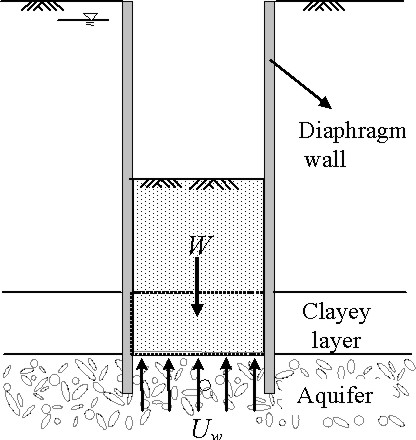
engineering & technology publications
ISSN 1759-3433
PROCEEDINGS OF THE TENTH INTERNATIONAL CONFERENCE ON CIVIL, STRUCTURAL AND ENVIRONMENTAL ENGINEERING COMPUTING
Analysis of Upheave Failure Induced by Deep Excavation using the Finite Element Method
+Department of General Education, Aletheia University, Tainan, Taiwan
*Department of Construction Engineering, National Taiwan University of Science and Technology, Taipei, Taiwan
$Department of Architecture, Hwa-Hsia Institute of Technology, Taipei, Taiwan
As shown in Figure 265.1, when an excavation case is located at a site with a
high-permeability aquifer beneath the clayey layer (so-called undrained layer) and the
diaphragm wall is penetrated into the aquifer, the upheave failure may occur during
excavation due to the fact that the total weight of soils, ![]() , above the aquifer in
the excavation zone is smaller than the upward pore water pressure,
, above the aquifer in
the excavation zone is smaller than the upward pore water pressure, ![]() . The factor
of safety against the upheave failure (
. The factor
of safety against the upheave failure (![]() ) is generally expressed as:
) is generally expressed as:
where
The analysis of the upheave failure using Equation (32) is quite simple. Generally, the friction between the diaphragm wall and soils is not considered in the analysis for conservative design. Besides, the soil upheave deformation cannot be estimated using Equation (32). As a result, the objective of this study is to establish a finite-element-method (FEM) analytic procedure which is capable of estimating the deformation behaviour of the upheave failure induced by excavation. The CRISP program [1] is used in this study. The interface element is employed in the FEM analysis to be able to properly simulate the upheave behavior. An ongoing construction of a station in Taipei Massive Rapid Transit is used to establish and examine the analytic procedure. Also, the effect of the factor of safety on the upheave failure is considered in the procedure. The soil parameters are determined based on Kung [2]. The results of the FEM analysis showed that the behaviour of the upheave failure, including the upheave failure surface, the critical excavation depth and the significant soil upheave deformation, can be properly estimated using the proposed procedure.
- 1
- CRISP Consortium Ltd. (2002). CRISP: CRItical State soil mechanics Program in 2 dimensions, user manual, Version 4.3, London.
- 2
- Kung, T.C. (2003). "Surface Settlement Induced by Excavation with Consideration of Small Strain Behavior of Taipei Silty Clay." PhD Dissertation, Department of Construction Engineering, National Taiwan University of Science and Technology, Taipei, Taiwan.
purchase the full-text of this paper (price £20)
go to the previous paper
go to the next paper
return to the table of contents
return to the book description
purchase this book (price £135 +P&P)

